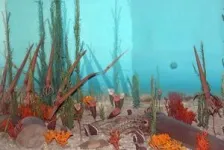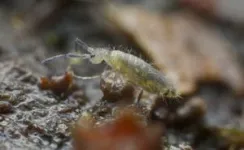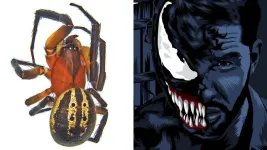(Press-News.org) The globe was hot and humid. The sea was teeming with life. Early squids, eel-like fish and sea worms hunted smaller animals. Above ground, however, nothing stirred. The animals had not yet crawled ashore.
That was what the Earth looked like about 450 million years ago at the end of the Ordovicium period.
The warm water created the perfect living conditions for wildlife. But this would soon change. Shortly after, the land masses would began to freeze and an ice cap start to spread.
The water, which had previously been warm and accommodating to wildlife, became cold and inhospitable. One species after another succumbed. In a short period of time, half of all life had been wiped as part of the second-worst mass extinction in the history of the planet.
One of the animals that survived, however, was the springtail. A small, insect-like animal that had developed a special strategy to combat the cold. The animal's cells had begun to produce proteins that could protect the cell from freezing.
The springtail might have been the first animal to ever develop antifreeze proteins. Scientists had previously believed that animals didn't begin to do this until much later. This is shown by research from Aarhus University and Queen’s University in Canada.
“We knew that antifreeze proteins had developed independently of each other several times during evolutionary history. Fish have them. Insects have them. Some spiders have them. But until we saw these results, we didn't know that they’d developed so early in the animal world," says Martin Holmstrup.
He is a professor at the Department of Ecoscience at Aarhus University and one of the researchers behind the new study.
SPRINGTAILS CAN BE FOUND EVERYWHERE – INCLUDING YOUR GARDEN
The springtail is a small animal, and the largest species of springtail are only six millimetres long. It has six legs and two antennae in front. It looks like an insect at first glance, but it's not. In fact, it has its very own branch on the evolutionary tree.
So far, researchers have found more than 9,000 different species of springtail, and they can be found almost everywhere – including in your garden. Springtails typically live in the upper layers of soil or in fallen foliage, where they feed on microscopic fungi, bacteria and other microorganisms.
The animal takes its name from its forked tail that it holds under its body like the bar of a catapult. The tail is also known as a furcula and the animal can release it quickly and leap up to 10 centimetres into the air if attacked by an enemy e.g. a spider.
Springtails are good for the health of soil because they help recirculate nutrients to plants.
Tiny animals in Petri dishes
Martin Holmstrup looks after almost 20 different species of springtails in the laboratory. The small animals don’t need much space. An entire colony can live in a single glass bowl, he says.
“We keep them in Petri dishes with a base of plaster that we can keep moist. As feed, we give them a little dry yeast. That's basically all they need,” he says.
The springtails in Martin's laboratory were the ones used in the experiment. He sent samples from the animals to three colleagues in Canada, who conducted a number of molecular experiments to find out when the animals first developed the antifreeze protein.
Because the researchers know the DNA sequence that enables cells to build the antifreeze protein, they can search for the same sequence across species, families and ranks. They can also calculate when the mutation that led to the genesis of the gene occurred: the Ordovician period.
"The calculations show that springtails developed the antifreeze protein long before other animals. It didn’t happen for fish and insects until a million years later. Although plants and microorganisms, such as bacteria and single-celled algae, might have developed a similar mechanism even earlier,” he says.
HOW TO FIND SPRINGTAILS
Martin Holmstrup and his colleagues at the Department of Ecoscience gathered the springtails for the lab themselves. They were gathered in Denmark, Iceland and Greenland.
They are not that hard to find, you can even find them in your own garden.
Just follow these steps:
Grab a handful of soil or foliage from your garden and place it in a sieve.
Place an adjustable lamp over the sieve and put a tray under the sieve.
The heat from the lamp will make the springtails search for colder environs. This will make them fall through the sieve and into the tray, where you’ll find them crawling around.
Encapsulates and slows down ice crystals
Although you can find springtails almost anywhere on the globe, they are more numerous in the Arctic than anywhere else. Only a small number of other terrestrial animals can survive the cold of Greenland and Canada, meaning the springtails can feed on bacteria and fungi undisturbed.
“The springtails' super-potent antifreeze proteins allow them to survive in cold regions where there they only have to share food with a few other worms and insects. And they don't have many natural enemies,” says Martin Holmstrup.
In winter, when temperatures drop in the Arctic, springtails begin to produce antifreeze proteins. They are also called "ice-binding proteins" because they can latch to the surface of tiny ice crystals and prevent them from growing bigger. Terrestrial animals come in close contact with ice crystals when the soil freezes, so antifreeze proteins play an important role in preventing the ice from spreading into the animal and killing it.
“Just like us - and most other animals - springtails can’t survive if their “blood” freezes to ice. The antifreeze proteins help prevent this,” he says.
Dry as a raisin
However, this special protein is not the only ability that makes it possible for springtails to survive in the harsh cold of the Arctic. They have another trick up their sleeve.
"Because every living thing has water molecules within its cells, we are vulnerable to freezing temperatures. If the water freezes, the cells are destroyed. To prevent this, the springtail allows itself to dry out and go into a form of hibernation over the winter,” explains Martin Holmstrup.
When springtails hibernate, their metabolism becomes so slow that scientists can't actually measure it. However, when spring arrives, they absorb water back into the body and restart their metabolism.
“You can compare them to a grape that dries into a raisin in a process reminiscent of freeze-drying. The springtails shrink and become small, wrinkly critters in winter. And then, when spring arrives, they absorb water and swell back to normal size,” he says.
Discovered in fish that should have frozen to death
For many years, it was a mystery how certain animal species could survive in the coldest regions of the planet. It wasn't until the middle of the last century that scientists discovered the antifreeze proteins that made it possible for animals to cope with the cold.
For decades, scientists had wondered how arctic fish were able to swim around seawater that was minus 1.8 degrees Celsius. The freezing point of seawater is lower due to its salt content. The blood of the fish, on the other hand, has a freezing point of minus 1 degree Celsius, which means they should not be able to avoid freezing in the water.
“How fish managed to survive in icy seawater was a mystery for a long time. However, in the late 1960s, the American researcher Arthur DeVries was able to isolate the proteins found in Arctic fish, which he discovered were able to prevent ice from forming in the cells and blood of the fish, even though the fish had been supercooled throughout its life,” explains Martin Holmstrup
Since then, researchers have discovered antifreeze proteins in a number of other animals, plants and microorganisms. And these antifreeze proteins are now being used by industry.
Today, antifreeze proteins play an important role in the food industry
A lot of food these days is bought and sold as frozen foods. However, the problem is that frozen food changes if ice crystals begin to form. They often diminish both the taste and texture of the foods.
However, this can be prevented by the special antifreeze proteins, explains Martin Holmstrup:
"The genes that encode the antifreeze proteins in fish have been copied into industrial yeast cell cultures. This makes the yeast produce the very useful proteins, which can then be added to different foods,” he says.
One of the foods where the proteins are particularly effective is ice cream.
"I know Unilever has used the proteins in ice cream because they help create a really lovely texture. The ice cream can also be thawed and frozen again without turning into a hard block of ice crystals. In the longer term, this effect could be used in connection with the cryopreservation of transplant organs.
“Other industries like the aerospace and wind turbine industries have also experimented with the proteins. They hope the proteins can protect wings from freezing and needing to be de-iced.”
END
Super antifreeze in cells: The ability to survive in ice and snow developed in animals far earlier than we thought
More than 400 million years ago, an insect-like animal called the springtail developed a small protein that prevents its cells from freezing.
2023-09-11
ELSE PRESS RELEASES FROM THIS DATE:
The important connectivity of metal oxides with hydrogen
2023-09-11
Understanding the interactions between materials and chemical species is critical for engineers as it helps them determine their best uses for both day-to-day life and global-level applications.
Metal oxides, a binary material of metal and oxygen, greatly interest researchers because of their importance in transforming energy storage, production, and conversion. To further those possibilities, a team from the University of Pittsburgh Swanson School of Engineering has determined a new way to view how hydrogen and metal oxides interact.
“Numerous experimental techniques have been used to understand this phenomenon – from spectroscopy to catalysis” explained Giannis ...
ETH Zurich chooses Symplectic Grant Tracker to promote world-class research
2023-09-11
Digital Science, a technology company serving stakeholders across the research ecosystem, is pleased to announce that ETH Zurich has chosen Symplectic Grant Tracker from Digital Science’s suite of flagship products to power its internal funding program, to promote world-class research with the potential to result in fundamental new knowledge or technologies and exciting discoveries.
Designed from the outset to meet research funding needs, Grant Tracker includes features to assist applicants, reviewers, committees and funders and help them to work efficiently and effectively across the grants management lifecycle.
The ETH Zurich Research ...
Cancer-causing mutations rewire growth signalling in prostate cancer model
2023-09-11
Key points:
The PIP3/PI3K signalling pathway is one of the most important signalling mechanisms in our cells, affecting cell metabolism and growth. It is also one of the most frequently altered pathways in human cancer.
Research from the Institute has shown that PI3K pathway remodelling is a common feature of cancers driven by hyperactivated PI3K signalling. Working in prostate tumour models the team identified an unknown activator driving PI3K signalling and cancer growth in a way that is released both from needing positive growth signals and also from growth-limiting feedback controls.
This knowledge identifies new ...
Study finds probation associated with poorer health for Black Americans
2023-09-11
“Mistrust all in whom the impulse to punish is powerful,” warned Friedrich Nietzsche more than a century ago.
Instead, the impulse to punish appears to have grown more and more powerful in the U.S criminal justice system. Annually, more than 9 million people a year in the U.S. are arrested, and on any given day roughly 2.3 million are incarcerated, representing a 500% increase in the prison and jail population since 1980 (compared to a 46% increase in the population over the same time).
This ...
University of Bath is home to UK’s first pilot plant for recycling plastic lab waste
2023-09-11
A company co-founded by a University of Bath graduate has opened the UK’s first pilot plant that can recycle up to 60% of plastic lab waste, to make back into new lab consumables. LabCycle hopes the technology could be scaled up in the future to recycle waste from healthcare, research and commercial labs that is currently incinerated or sent to landfill.
To avoid cross-contamination between experiments, most lab-based scientists use a significant amount of single-use plastic in their daily research, including pipette tips, test tubes, petri dishes and multi-well ...
Kessler Foundation scientists receive nearly $800,000 in federal grants to advance research in post-stroke neglect and autism
2023-09-11
East Hanover, NJ – September 11, 2023 – Three Kessler Foundation research scientists, Timothy Rich, PhD, OTR/L, and Co-Principal Investigators Helen Genova, PhD, and Heba Elsayed, MD, have been awarded $777,325 in federal grants by the National Institutes of Health (NIH) to expand research in the fields of neglect dyslexia and autism. These studies may provide major steps towards finding innovative solutions for individuals affected by these conditions.
Dr. Rich, research scientist in the Center for Stroke Rehabilitation Research, was awarded $626,889 to conduct research on “Gaze, Head Rotation, and Neuroanatomic Correlates of Reading Errors in Neglect Dyslexia.” ...
The venom spider: New genus named after Tom Hardy’s Marvel character
2023-09-11
Tom Hardy and his Marvel character Venom have given their names to a newly discovered Australian spider. The genus Venomius and its only current species Venomius tomhardyi were described following an expedition to Tasmania.
Scientists MSc Giullia Rossi, Dr Pedro Castanheira and Dr Volker Framenau from Murdoch University (Perth, Australia) partnered with Dr Renner Baptista from the Federal University of Rio de Janeiro (Brazil) to describe the new genus of orb-weaving spiders published in the open access journal Evolutionary Systematics.
Tom Hardy portrays Eddie Brock and his alter-ego Venom, an antihero closely associated with Spider-Man, across ...
Press registration now open for one of the world’s largest meetings in fluid dynamics
2023-09-11
More than 3,500 scientists from around the world will meet to present new research on the physics of fluids at the 76th annual meeting of the American Physical Society’s (APS) Division of Fluid Dynamics. The conference will be held in person only at the Walter E. Washington Convention Center in Washington, DC, Nov. 19-21.
News media with valid APS press credentials may register for the meeting at no cost. To request press credentials, visit APS’s virtual press office. Registration will remain open throughout ...
New ionic materials boost hydrogen fuel cell efficiency!
2023-09-11
A team of researchers, affiliated with UNIST has made a groundbreaking advancement in improving the efficiency of hydrogen fuel cells, which are gaining significant attention as eco-friendly next-generation energy sources.
Led by Professor Myoung Soo Lah in the Department of Chemistry at UNIST, the team successfully developed solid electrolyte materials utilizing metal-organic frameworks (MOFs). This innovative approach significantly enhances the conductivity of hydrogen ions within the solid electrolyte employed in hydrogen fuel cells. Furthermore, the research team ...
Researchers a step closer to effective heparanase inhibitor
2023-09-11
The cellular protein heparanase plays an important role in allowing diseases, including viruses and cancers, to spread within our bodies. For this reason, researchers investigating a wide range of diseases are eager to find an effective heparanase inhibitor.
Scientists from the University of Illinois Chicago, along with colleagues at the University of Georgia and Utrecht University in the Netherlands, found a molecule effective at inhibiting heparanase activity related to the herpes simplex virus and reduced the spread of the virus when tested on human cells. The new research is published in Angewandte ...
LAST 30 PRESS RELEASES:
First Editorial of 2026: Resisting AI slop
Joint ground- and space-based observations reveal Saturn-mass rogue planet
Inheritable genetic variant offers protection against blood cancer risk and progression
Pigs settled Pacific islands alongside early human voyagers
A Coral reef’s daily pulse reshapes microbes in surrounding waters
EAST Tokamak experiments exceed plasma density limit, offering new approach to fusion ignition
Groundbreaking discovery reveals Africa’s oldest cremation pyre and complex ritual practices
First breathing ‘lung-on-chip’ developed using genetically identical cells
How people moved pigs across the Pacific
Interaction of climate change and human activity and its impact on plant diversity in Qinghai-Tibet plateau
From addressing uncertainty to national strategy: an interpretation of Professor Lim Siong Guan’s views
Clinical trials on AI language model use in digestive healthcare
Scientists improve robotic visual–inertial trajectory localization accuracy using cross-modal interaction and selection techniques
Correlation between cancer cachexia and immune-related adverse events in HCC
Human adipose tissue: a new source for functional organoids
Metro lines double as freight highways during off-peak hours, Beijing study shows
Biomedical functions and applications of nanomaterials in tumor diagnosis and treatment: perspectives from ophthalmic oncology
3D imaging unveils how passivation improves perovskite solar cell performance
Enriching framework Al sites in 8-membered rings of Cu-SSZ-39 zeolite to enhance low-temperature ammonia selective catalytic reduction performance
AI-powered RNA drug development: a new frontier in therapeutics
Decoupling the HOR enhancement on PtRu: Dynamically matching interfacial water to reaction coordinates
Sulfur isn’t poisonous when it synergistically acts with phosphine in olefins hydroformylation
URI researchers uncover molecular mechanisms behind speciation in corals
Chitin based carbon aerogel offers a cleaner way to store thermal energy
Tracing hidden sources of nitrate pollution in rapidly changing rural urban landscapes
Viruses on plastic pollution may quietly accelerate the spread of antibiotic resistance
Three UH Rainbow Babies & Children’s faculty elected to prestigious American Pediatric Society
Tunnel resilience models unveiled to aid post-earthquake recovery
Satellite communication systems: the future of 5G/6G connectivity
Space computing power networks: a new frontier for satellite technologies
[Press-News.org] Super antifreeze in cells: The ability to survive in ice and snow developed in animals far earlier than we thoughtMore than 400 million years ago, an insect-like animal called the springtail developed a small protein that prevents its cells from freezing.







